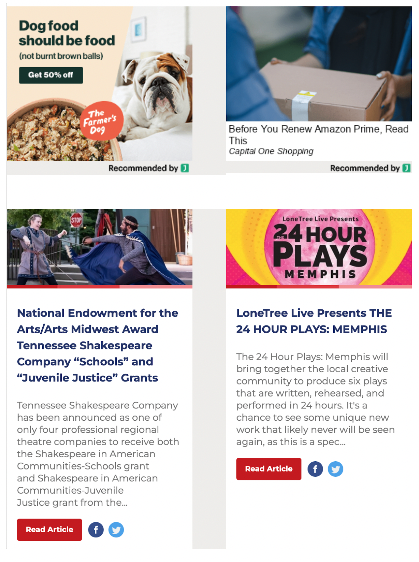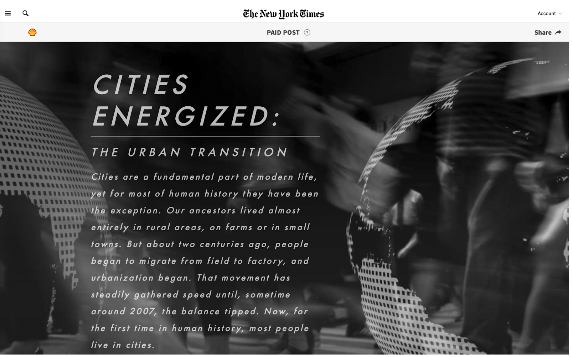Meta, the parent company of Facebook and Instagram, had big plans for innovative ad products when it launched in 2021. Halfway through 2022, however, the tech giant is still struggling to deliver performance for direct-to-consumer (D2C) brands
Frustrated with a lack of results, where are advertisers spending their budgets instead? On native programmatic ads, as Adweek reported.
“We moved money out of Meta. We haven’t necessarily moved it back yet,” Jason Dille, executive vice president of media at agency Chemistry, told Adweek. “The amount of attributable traffic and orders [on Facebook and Instagram] just is not as great as it used to be.”
Evidently, more advertisers are catching onto the benefits of native advertising. Since native ads blend into their surrounding content, for example, they provide what many other ad platforms can’t: more personalized and less intrusive customer experiences, an antidote to ad blockers and Apple iOS privacy changes, and a solution for diversifying your ad mix outside of the Facebook-Google duopoly.
So, if you’re looking to expand your native advertising outreach, we’re here to help.
Let’s unpack two key types of native advertising — native email ads and sponsored editorial content — and the metrics you need to gauge their performance.
Native email ads

Brands can create native ads that fit seamlessly into email newsletter templates, reaching engaged audiences of subscribers directly in their email inbox. Especially now that publishers are ramping up their email operations, e-commerce advertisers have a major opportunity to get in front of their readers with personalized, targeted email campaigns.
Just look at these native email ads in a newsletter from BroadwayWorld. They blend into the organic articles around them but include the necessary disclaimer, “Recommended by Jeeng.”
How do you measure native email ad performance?
You can measure native email ads with these key metrics:
- Impressions: The number of times your ad was shown. This is a standard ad metric, but it’s taking a backseat to more engagement-based metrics now that third-party cookies and new privacy restrictions are changing the way advertisers track and target their audiences.
- Clickthrough rate (CTR): The number of clicks on your ad divided by the number of times your ad is shown. CTR is the most important email ad metric that marketers can track.
- Conversion rate: The number of people who converted (such as by making a purchase, downloading an asset, or signing up for a trial) divided by the number of times your ad was shown.
- Return on investment (ROI): The amount of revenue generated by your campaign divided by the amount you spent on it.
Sponsored editorial content

Sponsored editorial content is a form of native advertising in which a brand pays to create a piece of media — like an article or video — for a publisher’s platform. With sponsored posts, advertisers can partner with reputable publishers to build long-form, immersive content experiences. The New York Times, for instance, created its T Brand Studio to create and run custom content with brand partners.
Shell, for instance, paid The New York Times to create this interactive post about urbanization and the evolution of cities:
How do you measure sponsored content performance?
If you’re launching a sponsored article, you can use these metrics to track performance:
- Page views: The number of times your article page is loaded or seen by a site visitor.
- Time on page: The amount of time visitors spend with your sponsored post.
- CTR: The number of clicks to your site or landing page divided by the number of times your post is viewed.
- Shares: The number of times visitors shared your post with others.
- Conversion rate: The number of people who completed an action divided by the number of times your post was viewed.
If you’re distributing a sponsored video, you can use these metrics:
- Impressions: The number of times your video is shown.
- Views: The number of times your video is watched.
- View rate: The number of times your video is watched divided by the number of impressions.
- Watch time: The average amount of time viewers spend with your video.
- Completion rate: The number of people who watch your whole video ad divided by the number of views.
- CTR: The number of clicks to your site or landing page divided by the number of views.
- Engagements: The number of comments, likes, or interactions with your video ad.
- Shares: The number of times viewers share your video with others.
- Conversion rate: The number of people who completed an action divided by the number of times your video was viewed.
You can also run sponsored email ads, which are email newsletters delivered by publishers but paid for by brands.
If you want to track native ad performance, you need a performance-based platform to help you automatically measure and optimize your campaigns.
That’s where Jeeng comes in. We have the tools you need to launch and analyze programmatic native ads across high-engagement channels like email, web pages, and push notifications — so you can diversify your ad mix and drive revenue.

